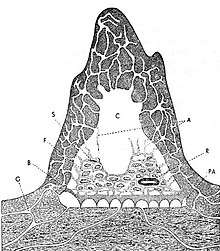Macrotermes natalensis
Macrotermes natalensis is a fungus-growing termite species, which belongs to the genus Macrotermes, commonly reported in South Africa. This species is associated with the Termitomyces fungal genus. M. natalensis has domesticated Termitomyces to produce food for the colony.
| Macrotermes natalensis | |
|---|---|
 | |
| Cross-section of mound | |
| Scientific classification | |
| Kingdom: | Animalia |
| Phylum: | Arthropoda |
| Class: | Insecta |
| Order: | Blattodea |
| Infraorder: | Isoptera |
| Family: | Termitidae |
| Genus: | Macrotermes |
| Species: | M. natalensis |
| Binomial name | |
| Macrotermes natalensis (Haviland, 1898)[1] | |
M. natalensis has become a well-studied fungus-growing termite species, and its genomic sequence reads generate 1.3 gigabytes of data, making it the largest insect genome to date.[2]
Colony caste system
All the fungus-growing termite colonies similar caste systems. Each caste plays a different roles in the colony, but it is not yet known how caste selection occurs. The primary reproductive caste or royal pair is made up of a king and a queen. The winged alates make up the secondary reproductive caste. Sterile castes do not possess any reproductive capacity and include workers and soldiers, both major and minor.
Termitomyces in a colony
Termitomyces fungi play a major role in termite nutrition. They also influence termite survival and caste development. The fungal garden is managed by the worker caste.
In a mature M. natalensis colony, older workers collect dead plant material along with Termitomyces asexual spores from their habitat and pass these on to the younger workers. The young workers only stay in the nest. They receive the plant material and ingest it along with the Termitomyces spores. Later, young workers defecate this blended plant material, along with fungal spores, somewhere in the colony nest. It forms a "comb", where the fungal mycelium establishes a dense network. The Termitomyces fungi use the nutrients from the comb and complete their life cycle with fruiting bodies or fungal nodules.
References
- Bignell, D. E.; Jones, D. T. (2014). "A Taxonomic Index, with Names of Descriptive Authorities of Termite Genera and Species: An Accompaniment to Biology of Termites: A Modern Synthesis". Journal of Insect Science. 14 (81): 34. doi:10.1673/031.014.81. PMC 4212872.
- Poulsen, Michael; Hu, Haofu; Li, Cai; Chen, Zhensheng; Xu, Luohao; Otani, Saria; Nygaard, Sanne; Nobre, Tania; Klaubauf, Sylvia (7 October 2014). "Complementary symbiont contributions to plant decomposition in a fungus-farming termite". Proceedings of the National Academy of Sciences of the United States of America. 111 (40): 14500–14505. doi:10.1073/pnas.1319718111. PMC 4209977. PMID 25246537.